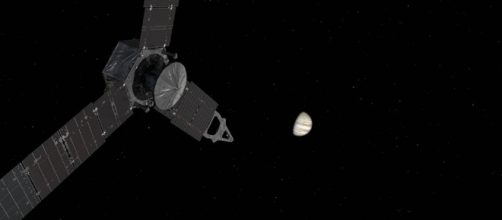After almost five years of travelling through space in the direction of Jupiter, Juno spacecraft was locked into an orbit round Jupiter which will allow it to fly near the gas planet north pole and avoid the dangerous zone of the planet´s radiation belts. The space vehicle is planned to make two 53.5 days orbits around the giant planet before its main engine is fired up again to locked it into its final 14 day orbit around Jupiter.
Apojoves and perijoves
Perijove is the closest distance, while apojove is the farthest distance, thus perijove is Juno´s closest distance from Jupiter and perijove is Juno´s farthest distance from the big planet.
The first Juno´s perijove started on July 4th at the moment of its orbit insertion around Jupiter and the first apojove will occur on July 27- when the spacecraft reaches its farthest distance from the giant planet.
Juno is on its path to apojove
At this moment, Juno is on its way to apojove (farthest distance from Jupiter), following an elongated path that extends beyond the orbit of the Jovian moon Calisto. After going throughtwo more apojoves, Juno will undergo a series of maneuvers or burn phases that will placed it in a 14 day orbit around the gas giant. Following this, the spacecraft will conduct the majority of the science investigations for which it was designed.
Juno´s highly elliptical orbits
To accomplish the science objectives of this mission, scientists designed a highly elongated orbit that approaches Jupiter on its north pole, allowing it to study the auroras. On each approach, the spacecraft’s distance from Jupiter will vary from 4,000 km (2485 miles) to 9,000 km (5,592 miles). This orbit allows the space vehicle to cover Jupiter´s entire surface. This orbit allows the spacecraft to be detected by Deep Space Network Antennas on earth.
Mission
Juno mission´smainsciencegoal is to deepen scientist’s understanding of the formation and evolution of Jupiter. It will also research into the Jupiter´s atmosphere, structure, its interior and magnetic and gravitational fields. The research conducted on the gas giant will help astronomers to gain a good understanding about the origins of the solar system and other gas giant planets in other distant galaxies

